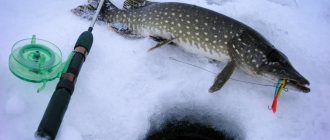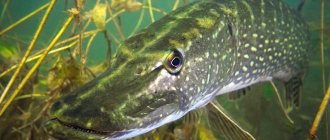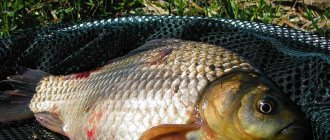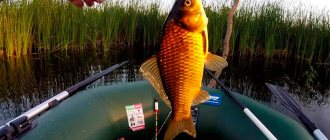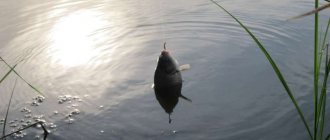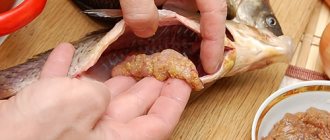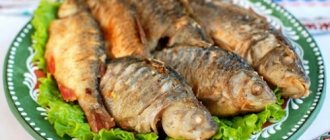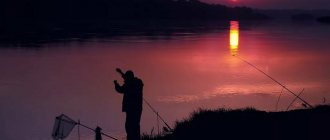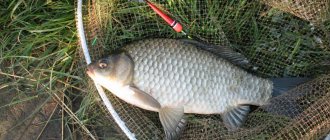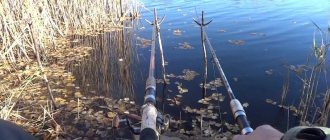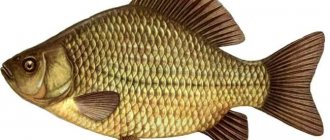Content
- Fishing for crucian carp in early spring. Where to look for fish?
- In which bodies of water should you fish on the last ice?
- When does crucian carp start biting in the spring?
- Fishing tactics
- Fishing technique
- Safety on the last ice
- Catch rate
- Video: Catching crucian carp in winter with a jig
Where to start hunting after he has awakened from hibernation? Experienced fishermen wait for this moment all winter, because after a long winter of fasting, the fish begin to feed very actively and bite like a machine gun! Fishing at this time is very exciting, and if you successfully get into the “grab” you can catch more than tens of kilograms.
Water temperature
Crucian carp wakes up with the onset of spring warmth. The main condition for a good bite is warm water. The optimal temperature here is +10 degrees Celsius. Under such conditions, small rivers and ponds, as well as coastal zones, warm up first. In such places, crucian carp can be caught even in the last days of March. In mid-April, fish living in shallow ecosystems with a dark muddy bottom begin to become active.
For many fishermen, an interesting question is: “When does crucian carp start biting in the spring in the Moscow region?” The zhor of fish in this region appears immediately as soon as the water warms up to +7 degrees Celsius. It is noteworthy that it is very difficult to catch crucian carp in reservoirs near Moscow after winter without bait.
The crucian carp, which live in large ponds with a deep bottom, wake up later than everyone else. If there are cold currents in them, then you can’t expect a bite before the end of May.
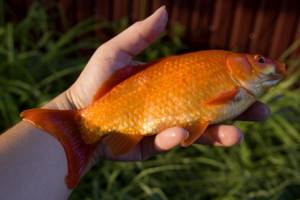
You also need to take into account the fact that spring is different from spring. One year it is warm, and the other, on the contrary, cold.
If we touch on the question of when crucian carp begins to bite in the spring in Moscow, then it should be noted that many fishermen deliberately begin hunting for it only at the end of May, when spawning takes place.
Fishing for crucian carp in early spring. Where to look for fish?
Fishing for crucian carp is a fishing favorite of many anglers since childhood! How stubbornly he resists when playing! How beautifully the float sinks and leads to the side. How wonderful is crucian carp on the table? Properly cooked in sour cream, it is one of the most delicious classic fish dishes.
You should not look for happiness and hope for a good bite of crucian carp in a pond heavily overgrown with grass and mud, even if you know that there is fish there and it is caught well in the summer. Remember, in early spring crucian carp is not actively caught in all places. A good bite occurs only in relatively clean reservoirs, with reeds along the banks, but not where the bottom is too silted and overgrown with grass. This is due to the fact that in silty and heavily overgrown ponds and lakes, due to the low concentration of oxygen in the water, by the end of winter, the activity of the fish is extremely low, or they generally still sleep, buried in the silt. It waits for the water to break up from the ice so that oxygen access can be fully restored, and only then does it begin to eat away.
Popular methods of catching crucian carp in spring
A huge number of ways can be listed.
The oldest one is a float rod and a can of worms. That's the whole recipe. The only thing that should be added is that it is better to choose a harder rod if you have to fish in overgrown places.
There is another option - catching crucian carp from the middle of the pond. To do this you need to have a fairly long fishing rod, but it is quite inconvenient and noisy. To get around the unpleasant moments, tricks were invented. You need to take the rod and reel, place a transparent float on the edge of the fishing line, and after about one and a half meters you need to tie a leash with a hook.
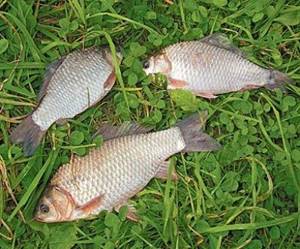
After this, a pair of worms or maggots are strung together. You need to notice in advance where approximately the crucian carp emerges, and then cast.
It is better to throw a little further from the place where the fish approximately live. If no splashes are observed, then you can slowly pull the bait towards the boat.
If desired, you can install additional small floats where the leash is attached. This can be done if the main one is difficult to see.
Another way is to use a rubber band. It is advisable to place the load before sunset on the boat. It is better to do the tension up to 12 meters.
The rubber is attached using a swivel with a 10-20 meter long undergrowth. Before you start fishing, you need to bait the hooks, and then lower them according to the tension of the rubber.
This moment can be felt when no resistance is felt.
The leader will be on the bottom, and the main line attached to the peg using a loop. If desired, you can hang a bell.
You can give an example of the most common kit for a carp hunter:
- regular light reel;
- The diameter of the main line is suitable in the range from 0.16 to 0.2 mm. For a leash, you can choose a thinner one;
- It is better to select a six gram float;
- hooks are suitable with numbers from four to six.
The following bottom gear is suitable:
- an elastic band, the method of catching which was described a little earlier. With its help you can catch several baits at once;
- nipples. They are a small metal rod with a weight at the base. This entire structure is wrapped in wire. When fishing, bait is stuffed inside;
- springs;
- feeder;
- picker;
Nipples and springs are ideal for crucian carp, because they love to suck in food. In this case, the hooks are hidden in the bait and the fish swallows them and hooks them.
Feeder and picker jigs are very sensitive and are quite popular these days. The rod is usually about three meters, the reel is two thousandths, the fishing line is in the range from 0.16 to 0.2 mm and the feeder is about 30-40 grams. If the crucian carp twitches even a little, the fisherman will immediately be able to notice. This is ensured by a sensitive rod.
It is worth remembering that hooks become dull very often and have to be changed. It is better to do this almost every fishing trip, because if the fish breaks very often, then it is not the skill that is to blame, but the hook.
In addition to everything described above, do not forget about bait. You can buy it either in a store or make it yourself, which is what a huge number of fishermen actually use. You can do without bait if you fish in the spring, because crucian carp are especially hungry at this time and will eat everything they can get their hands on.
But it may also happen that you have to lure fish, and this is where an additional device comes to the rescue - bait. The simplest would be a round ball consisting of breadcrumbs, crushed biscuits, semolina and water. You can add a few drops of flavoring.
In which bodies of water should you fish on the last ice?
General recommendations are, of course, good, but where exactly to catch crucian carp on the last ice in our area? Of course, first of all, this is a Mecca for crucian carp fishing - Lake Chany, Lake Yarkul, and the mines between them. Numerous lakes in the Krasnozersky and Karasuk districts. Lake Studenoye, Red, Good and others. Flood lakes of the Altai Territory. There are a lot of crucian carp in the listed lakes! The most important thing at this time is to find its accumulation in the reservoir; the fish are not distributed evenly. Somewhere there will be more comfortable conditions and parking places for him, both in terms of oxygen concentration in the water and in terms of food - RNI (Fish Must Be Looked for).
I won’t recommend nearby rivers, because... The ice conditions on them are not stable.
By the way, news has already appeared that the crucian carp in Chany has begun to stir, but its activity depends on the weather. Looking through information from previous years, I came across an excellent report describing similar fishing on Lake Chany. Or, for example, this is indicative news from one of the places described above.
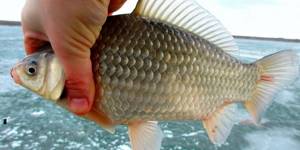
What time to catch crucian carp
Often crucian carp actively feeds early in the morning, from 5 to 8 am; activity decreases during the day; by 6 pm the feeding continues. It is worth noting that the biting time depends on weather conditions. In clear weather, crucian carp are active during the day, feeding near the shore, but avoiding excessively sunny places.
When the water warms up sufficiently (at noon), the peak of the bite occurs, but subsequent daytime heat can negatively affect the bite. If the street is warm but cloudy, crucian carp will be less successful in catching, it will allow you to “snap”, but no more. In rainy weather, when the temperature drops, you can safely pack your things - due to changes in atmospheric pressure, there will be no crucian carp until favorable weather sets in.
Crucian fishermen note that crucian carp are sensitive to the direction and strength of the wind. The higher the wind speed, the more wary and “nervous” the fish behaves. Eastern and northern winds have a negative impact on the bite; fish in the western or southern winds - then the chance of a successful bite is higher.
Spring fishing for vigorously resisting crucian carp, like any other fish, is a pleasure. But fishing is not always successful; there can be many reasons for this: unfavorable weather conditions; fish spawning; wrong choice of time, place or equipment; lack of necessary bait. To learn all the intricacies of crucian carp fishing, learn as much as possible about the fish, watch it and practice fishing, because everything comes with experience, so don’t be afraid to try!
Today there are two species of pond crucian carp - silver and golden carp. The golden one lives mainly in swampy reservoirs of low areas. It has its own characteristics that distinguish it from carp. The first and main sign is the absence of a mustache, the second is the round shape of the body, flattened from the sides. Silver crucian carp lives everywhere, mainly in rivers. The curve of the back of the goldfish is not as steep as that of the goldfish, and they are noticeably different in color.
Crucian carp can be caught very well at any time of the year, but each period has its own characteristics. The pre-spawning period is of great interest in catching crucian carp. At this time, the fish are gaining strength for the upcoming spawning, crowding together in certain places and biting very well. It is at the beginning of spring, when there is still no algae and natural food for crucian carp that can be successfully caught.
When fishing in spring, especially at the beginning of spring, you should pay due attention to the water temperature. Therefore, it is advisable to take a thermometer with you when fishing. You can start spring fishing for crucian carp already at 8°C, but when the temperature reaches 13-15°C, there is no point in catching crucian carp - it begins to spawn.
Since the temperature is different in different places, you need to look for it in warmer areas. Any fish after hibernation goes to where there is food, that is, in shallow water. The depth of such shallow waters is approximately 0.5 - 1 m.
Bottom sediments, crustaceans, insect larvae, mollusks and other animal food occupy a large place in the diet of crucian carp. But plant food also plays a big role in the nutrition of spring crucian carp. When duckweed appears, he immediately moves to these places and arranges a feast for himself. Plus, duckweed is always carried to the shore, where the water is warmer, so there is a high probability of meeting a school of crucian carp in such a place. In this case, it is better to fish with plant baits.
Bait for crucian carp in spring
You need to feed the fishing spot a little at a time. It is important to add part of the bait you plan to fish with to your bait mixture. In May, crucian carp take well on worms.
When there are a lot of roaches in the habitat of crucian carp, it is better to use a granular bait mixture so that this little thing cannot eat everything at once.
It is in the spring that animal components should be added to the bait for crucian carp. At this time, you should not feed the fish, it should whet your appetite. Try to add simple ingredients to the bait mixture so that the fish does not suspect anything. Approximately, the bait should contain about 5-7% protein (milk powder), 5-7% egg powder, 15% maggots and bloodworms. The rest is cereal. To tone down the color of the bait, you can use rye bread or a little coastal soil.
Today, fishing stores sell ready-made bait mixtures that are designed for different seasons, water temperatures and fish. Manufacturers take into account all the physiological characteristics and needs of fish in a certain period and, accordingly, use this in practice. Knowing the intricacies of the fish’s body, you can control it with the help of various components contained in bait (smell, color, taste of bait, etc.). Therefore, in order not to bother at home, you can buy everything in the store, but it all comes down to money and your capabilities.
As for flavorings, it is better not to use them in the spring, but to create the smell naturally (garlic, macadamia, hemp grains).
Baits for spring crucian carp
Most of all, crucian carp loves worms, pearl barley, bloodworms, maggots or maggots. Oatmeal dough sometimes works well. It is prepared in this way: crushed oatmeal is poured into a saucepan and a little boiling water is added. After it has cooled a little, you need to roll it into a ball. Knead it until the ball stops sticking to your hands, while adding a little sunflower oil.
When you go fishing, you should take with you several baits of both plant and animal origin. The fish may have different moods, which will determine the preferred bait.
When choosing a bait, it is important to take into account the presence of other fish in the pond. That is, the size of the bait must correspond to the size of the expected prey, otherwise the small things will constantly knock down the bait, and you will not catch anything worthwhile.
In bad weather, you won’t be able to fish in shallow water in the spring; there won’t be any bite. The crucian carp comes out to small areas in sunny weather to soak up the sun. In bad weather, the opposite is true - the crucian carp goes deeper and bites worse.
How do you catch crucian carp in the first months of spring?
You should start spring fishing for crucian carp in mid-April, when the water warms up to 12°C and the crucian carp runs aground. It is during this period that you can successfully catch this fish.
First of all, crucian carp become active in small ponds and stakes, where the water warms up faster. Next come reservoirs and rivers. Moreover, the gap in biting time can reach half a month.
You need to go after crucian carp at lunchtime; in the morning it doesn’t bite.
Since there are often frosts at the beginning of spring, this has a very good effect on the bite of crucian carp. During such periods it weakens or stops altogether. Therefore, temperature in spring plays an important role. It can either slow down metabolism or speed it up, and the upcoming spawning requires a lot of effort. This means that the fish must eat a lot.
Catching crucian carp with a float rod
Since we are fishing from the shore, we will need a plug rod 4-5 m long, but it is quite possible to use a regular fly rod. The advantage of the plug is that it can accommodate ultra-light and thin equipment. For crucian carp, a fishing line 0.1 mm thick and a float with a weight of 0.4 g are quite suitable. The float can be made from improvised means (goose feather).
It is very good to use a float with a weighted keel so that it stands vertically in the water without additional weight. This option is very convenient, because if the bait itself is heavy, then you don’t need to put a weight on it, but if on the contrary, then you can quickly put it on. In calm and windless weather, it is very convenient to use thin needle-shaped floats; the bite and feeding horizon of crucian carp are clearly visible on them.
It is better to select hooks according to the color of the bait and its size. It is better to place a silver-plated hook on maggots, a red one on bloodworms, and a black or “copper” hook on a dung worm. The size for maggots and worms is 8-10 number, for bloodworms they take a smaller number 16-18. The numbers are presented in the international classification. For plant baits you need to take something in between – number 12-14.
The tactic of fishing with a float rod is to silently lower the bait to a certain point, after which it can be moved to another point. If the bait is close to the fish, then it will definitely bite on it.
It’s not very good when crucian carp walks on top and in the middle of a reservoir. In this case, the bait with a float needs to be thrown further away, 10 meters from the school. After this, the bait can be pulled closer to the fish. But such a maneuver requires skill and dexterity, so you will have to work a little on your casting accuracy. Since the float is located quite a distance from you, and bites are not always clearly visible, it makes sense to wear polarized glasses.
Spring crucian carp on donka
Since float tackle does not always work well, you can use a donkey. There are 3 most common methods: donka with an elastic band, “free donka” and donka with a feeder.
Donka with a feeder
The design is the same as conventional feeder equipment for carp. The gear consists of a fishing rod and reel. The rod is ultra-light, since the crucian carp itself is not large (test 30-60 g). In another way it can be called a light feeder.
An inertia-free reel is placed on such a feeder, on which a fishing line with a diameter of 0.1-0.2 mm is placed. The feeder weighs about 20 g. This type of equipment is good because you can immediately feed and throw in the bait.
You can buy feeders or make your own. At home, it is made from copper wire, which is wound onto a frame. The ends of the feeder are sealed with a layer of lead, holes are made in them so that the fishing line can be passed through them. A metal or plastic tube is inserted into the holes. To stop the feeder, use a swivel to which a leash (15-20 cm) is tied.
The abandoned equipment is placed on a stand, and a bell is attached to the end of the rod or fishing line to better see the bites. As for the length of the rod, a short rod (1.5 meters) is used in thickets; in a wide area, the optimal length of the rod is 2.1 m.
If you fish at night, it is good to use a donka with an elastic band.
. Now it can not be used everywhere, but it is an old and proven method that works well. Therefore, if there is such an opportunity, it is better to try fishing with this tackle.
Such tackle contains in its design a heavy load, a well-stretched and thin piece of rubber. A fishing line with leashes is attached to this elastic band. The load is thrown over a long distance or they swim with it to depths, where they are also thrown to the bottom. A fishing line is attached to a peg driven on the shore, on which they place an alarm (bell, firefly) and wait for a bite.
If you are sailing with a load on a boat, then you can at the same time bait the place where the leashes will be approximately located.
In order not to miss a bite, they hold the fishing line on their finger or sit next to the tackle. This way you can attract additional attention from the fish by gently tugging the line.
But, it is important to remember that the spawning of fish produces future offspring - a future catch, and catching fish in the pre-spawning period or during the spawning period is undesirable. If you fish during this period, then know the extent of your appetite, since it takes time to restore the fish population, and you can catch everything very quickly.
Video Spring fishing for crucian carp:
On small indoor ponds in clear, calm weather, crucian carp can be caught well from the first days of April, but the intensity of the fish’s bite depends quite strongly on the level of water temperature. If the water is not yet warm enough, then most likely the fishing will be unsuccessful. And even if the crucian carp are fattening with all their might in the shallows, you still often have to stupidly look for the fish, and it can take several hours before it is found. Some experienced crucian fishermen on ponds prefer to catch crucian carp using a pickerel, but if the fish is huddled in thick grass, then it is simpler and easier to catch it using float tackle - in windows clear of thickets.
The float equipment itself is as lightweight as possible and does not exceed half a gram. It is advisable to slightly overload the float (sinker weighing 0.6-0.7 g), so that only the tip of the float antenna sticks out of the water. With such a load, the float clearly shows even the slightest touch of crucian carp to the bait. But such fishing is carried out in a short distance and is no longer very suitable for catching large crucian carp, maximum for fish weighing up to 500-600 g.
Catching a pond sage with a rubber donk can be very productive in spring ponds. But why does crucian carp use an elastic band? You can fish with such gear a week or two after the ice on the pond has completely melted. Usually the water in a reservoir during such a period is as clear as a tear, but it is already much warmer and has gained enough oxygen, because the first spring algae have begun to grow. This means that the small insects also woke up (especially on warm, sunny days), and the pond crucian carp went to hunt for them. But most often in April the crucian carp is kind of sluggish, lethargic, and even very cautious.
Often, in most ponds near the shore in early spring there is still not enough grass, and crucian carp prefer to stay away from the shore, closer to the central part. If the bed of the pond is narrow, then it is quite problematic to really catch it with long-distance float casts, but crucian carp are most readily taken on gentle slopes - edges that adjoin the bed itself, and in such difficult conditions, a rubber bottom is a great help in the spring.
The equipment for a pond bottom includes a sinker, which is tied to a short piece of strong nylon cord, and then a 10-12 m piece of strong aircraft model rubber is attached to the cord. Then a 2-3 m piece of fishing line 0.25 - 0.27 mm with leashes 15-30 cm long and hooks No. 6 is tied to this segment through a carabiner. Then (again through the carabiner) a piece of main line 0.35-0.4 mm is passed and it is wound onto a reel suitable for this. A sinker weighing about 0.3–0.4 kg can be thrown into the water and from the shore at 30-40 meters; this distance is usually enough for successful fishing.
With significant warming, crucian carp in the spring move away from the riverbed to vast shallow bays (no more than 1 m deep) and warm up there, but still rarely approach the shore itself. Then it makes sense to install a rubber donk in such a bay. Points that are quite promising for fishing are where young grass begins to sprout along areas with last year’s old vegetation.
As a rule, crucian carp do not react well to various types of plant baits in early spring and require “meat”, which is what should be offered to crucian carp. Preferably an ordinary dung or earthworm. Moreover, it is imperative to place live, moving worms on the hook, and in addition it doesn’t hurt to pinch its tail so that it wriggles even more seductively. But it often happens that spring crucian carp are lazy and only suck or tear off the ends of the worm, then only short tails no more than one centimeter long should be baited, although the costs of the worm are significant, but the benefit from this will be significant.
It is not always worth using complementary feeding in early spring on many ponds. Firstly, anyone who often fishes in this reservoir always knows exactly where the crucian carp are located in the “egon” pond. Secondly, it has been noticed that complementary foods immediately attract small white fish, which are also quickly followed by small perches. And if they come up, then they will constantly pull the worm off the hook, and it’s unlikely that good crucian carp fishing will happen. In early spring, crucian carp often bite somewhat sluggishly.
Its bite is then cautious and uncertain, and choosing the moment for a successful hooking is problematic, and the fish itself may not be detected as it should. Knowing this, some experienced crucian fishermen resort to some trickery - they do not use a bell or any other hanging alarm. The main line from the reel goes into the water in the usual way and is slightly stretched. It’s worth hooking immediately after a slightly noticeable movement of the line. This kind of fishing is quite active, and you must always be alert to the tackle; you often need to take the line in your hand to feel the weak crucian carp pokes - touches.
A successfully caught fish on an elastic band moves widely - the equipment itself perfectly smoothes out the jerks of large crucian carp, which makes it possible to install leashes made of relatively thin lines (0.12-0.15 mm) on the tackle. But the rather delicate lips of a crucian carp can break off when lifting a trophy onto a steep bank, so when carefully bringing the fish to the shore you should definitely use a landing net. Therefore, if on some ponds or lakes, crucian carp are not allowed to get close to them in early spring, then such a catchy tackle as a rubber band can help out the fisherman and will become a good assistant even with a single hook - it has been tested in spring on reservoirs, and more than once.
As a rule, around the end of April, spring crucian carp reduces the intensity of their bite because they move to areas closer to the shores, switching to feeding more on various young roots of underwater plants and duckweed. This phenomenon is clearly visible in sunny, clear weather by the slight movement of the lake reeds, and often you can even hear the characteristic crucian chomping sound in the young duckweed. In such areas, crucian carp often prefer to spawn, and they are caught there, but with ordinary float rods.
The depths in such places are usually minimal, so the worm is carefully lowered under the very carpet of duckweed or between the reeds. They often fish with a rod without a reel, in a plumb line, and often don’t even use a float. Having broken through the layer of duckweed, they slowly move the delicious worm on the hook underneath it.
If the crucian carp is standing nearby, then it grabs the bait immediately, and then the main thing is to quickly lift the fish above the green carpet so as not to alert the rest of its brothers. And therefore, in such conditions, crucian fishermen use a fairly thick fishing line (0.23 mm), without any leash. Such fishing can be very successful, but in order to approach the wary crucian carp, in many reservoirs it is necessary to enter the water in swamps or use a boat.
Even an experienced fisherman cannot give an exact answer. This fish lives by its own rules.
However, only the most basic factors can be identified:
- Features of the reservoir. It can be either deep or shallow, with or without a large number of holes.
- Weather.
To the first point we can add that if the reservoir receives warm water masses, then the crucian carp will behave exactly the same as in the summer. This can also occur near a nuclear power plant, where there is a warm channel. It can bite there even in winter.
In ponds and lakes, there may not be a thick layer of soil at the bottom and therefore the crucian carp swims from one place to another. If this is not observed, then in cold weather, he usually sleeps.
When does crucian carp start biting in the spring?
Active biting for crucian carp usually begins in early April. The ice thickness on lakes and water meadows is still quite decent. Fishing occurs mainly at shallow depths, near reeds or sedges, where crucian carp go out to feed. In these places, the water temperature rises faster, and it is saturated with oxygen from melt water. Comfortable conditions lead to active biting.
The peak bite for crucian carp on the last ice begins after 11-12 noon. It depends on weather conditions and solar activity. A simple pattern is being observed. If the weather is nice, sunny, warm, then the crucian carp will bite confidently; if it’s cloudy and frosty outside, then the fish will most likely bite sluggishly and reluctantly. Crucian carp is also sensitive to fluctuations in atmospheric pressure.
When do they start catching spring crucian carp?
In summer, crucian carp becomes picky and does not want to take any bait.
In spring, crucian carp are found in shallow overgrown reservoirs. Aquatic vegetation begins to rise quickly at a temperature of 12-15 degrees Celsius. At this time, the crucian carp is hungry and actively feeding. Usually this is the end of April and the first half of May.
In early spring, fishermen for crucian carp walk along the shore in places of grass and various thickets. Small individuals feed near the shore, while large ones stay in deep places.

In southern latitudes, this fish spawns in May, and in northern latitudes - in June. The weather influences here, the temperature should be at least 15 degrees. Crucian carp gather in schools and spawn among aquatic vegetation. The eggs stick to waterfowl and spread to other bodies of water. Typically, spawning in warm weather occurs within 2-4 days.
When the crucian carp starts to bite, the water has already warmed up. For a small reservoir, 4-5 days will be enough for this; for a larger one, more than a week.
A strong zhor occurs immediately after hibernation and lasts two to three weeks until spawning. During spring frosts, the bite stops.
In spring, crucian carp spawning ends on average in the first half of May, it all depends on the water temperature.
Fishing technique
When catching crucian carp, active play with a jig is not required. Rather, on the contrary, it will be caught either by “standing” or by small, smooth swaying of the bait at the very bottom. Usually they fish with several fishing rods at once, every now and then lifting and shaking the nozzle by the nod. Some people equip their fishing rod with a float, while others prefer a nod – this is not for everybody.
At this time, bloodworms, maggots, jigs, and worms are used as bait. The preferences of crucian carp depend on the specific body of water. A combination of these attachments often helps out a sandwich. They are most often fed with mormysh; vegetable baits are not particularly held in high esteem by fish at this time. But to attract the attention of the fish and create a cloudy column, you can add “dusty” complementary foods.

Crucian carp are quite cautious, even when hungry. He tries the bait several times, and if nothing bothers him, only then will a confident bite follow. Therefore, be patient, you should not hook from the first movement of the nod, let the fish swallow the bait. This is the skill and endurance in such fishing.
They use different jigs; it is better to use more powerful ones with strong hooks. In some reservoirs, crucian carp continue to feed at night. For night fishing, it is better to use light-accumulating jigs coated with phosphorus.
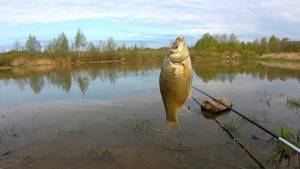
Consider the strength of this fish. Sometimes worthy specimens of large crucian carp fly in and put up a real fight with thin tackle. Sometimes carp and carp are caught as bycatch. It's a shame if the tackle can't withstand the heat of the fight.
It is necessary to catch crucian carp hastily, although in cold water it still does not resist at full strength. But it costs him nothing to break the jig or straighten the hook with his weight, making another somersault.
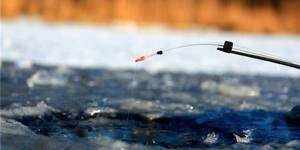
Secrets of fishing
There are several secrets to help you achieve your desired catch.:
- Opposite shore effect . When casting the tackle under the opposite bank, the likelihood of catching a trophy increases. It is here that a trophy crucian carp can be caught on a fishing rod in the spring when it begins to bite our desired object of hunting.
- Two centimeters . For capricious fish, even a slight change in the depth of the bait plays a positive role in its capture.
- Live bait . If activity disappears, you can move the float a short distance using a fishing rod. Often after using this technique a bite follows.
- Geyser . If bottom gear is used for fishing and the performance begins to decline, effervescent tablets added to complementary foods can come to the rescue. When it comes into contact with water, a gas is released, rising to the surface in bubbles and attracting fish.
- Crucian carp trails . In deep water bodies, fish move along certain routes. They are called paths. Having found the trail, the fisherman is sure to achieve a record-sized catch.
There is a secret to catching a really big trophy.
Large crucian carp are disturbed by their smaller relatives. They are faster and the first to take the bait off the hook and do not give it a chance to be caught. But there is a way out. First, you need to feed one point a little, then move to the side and feed the second point. All the small stuff will go to the first point, and large specimens will get their chance to be caught at the second point. Article on the topic: Fishing line for crucian carp
Safety on the last ice
The most extreme and adventurous fishermen go fishing at the end of April, when the shores have already moved away. The fish is overactive at this time. To go out on the ice they use boats, they are more reliable, sometimes just boards. The main thing is to overcome this water barrier, then the ice is still quite good. And the fishing depth is not great.
We recommend that you be as careful as possible and follow the safety rules! Do not go out on the ice alone, wear float suits, and have ropes and life preservers with you. Remember - no fish bite or fishing excitement is worth your life and the worries of your family.
What determines the start of crucian carp biting in the spring?
The activity of fish is greatly influenced by the natural conditions of the reservoir in which it lives. The degree of warming of the river and lake, and, consequently, the appearance of fresh algae and worms, as well as other components from the diet of crucian carp, depends on its depth. Weather conditions also play a significant role. It is the appearance of food in sufficient quantities that forces the fish to come out of hibernation.
The fish needs to regain its strength as quickly as possible, because it needs to be in time before spawning begins. This means that the crucian carp has only 2-3 weeks. Therefore, with the first warm days in March, the fish already begin to actively obtain food for themselves.
Crucian carp spawning
The breeding season for fish begins in April, as soon as the water warms up to the required temperature. In the northern or eastern regions of our country, the necessary conditions may appear only in May. Crucian carp that have reached the age of 4 years take part in spawning.
This process itself is gradual and lasts for two weeks. At one time, the female lays 150 thousand eggs, and most of them usually go to feed other fish. In total, she makes an average of 5 visits.
The crucian carp is completely devoted to the process and does not bite at all during this period. After a month, the female can already repeat spawning, if weather conditions allow, and more than once. Therefore, this process may drag on until early July.
Spawning sites are chosen where there are dams or spills. Lake representatives settle closer to the shores. After this process is completed, the crucian carp returns to its original habitat.
Interestingly, in the absence of a male individual, a female crucian carp can spawn with other representatives of the cyprinid family. The released eggs are not completely fertilized and only females are born.
Temperature conditions in the reservoir
As noted earlier, spawning of crucian carp occurs when the optimal water temperature is reached. For different types of fish, these numbers may not be the same. For example, marks of 13° are sufficient for silver crucian carp. But the golden “brother” prefers warmer water at 17°.
You can go fishing for crucian carp in the spring when the air temperature is above 10°, which lasts for some time. A small pond will warm up within 4 days. For larger rivers or lakes, you should wait a little longer. Fishing begins where there is a muddy bottom.
Time of day when crucian carp bite well
There is also no clear answer here. It has been noted that good fishing begins at dawn, that is, around 6-8 o’clock in the morning. She can then be active all day if it is cloudy outside. In sunny weather, the crucian carp goes closer to the bottom. In the pre-sunset hour, a good bite is also noticed among these individuals.
Temperatures and weather that are conducive to fishing
- The optimal spring temperature is approximately 10–15 °C. If it decreases, the crucian carp becomes inactive and lethargic, while hibernating. When warmth appears, the bite resumes.
- Windy weather has a good effect on fishing, especially if it blows from the south or west. Sometimes it’s good to fish in other wind directions. But at the same time, there should be no surges in atmospheric pressure, which have a bad effect on freshwater individuals.
- Cloud cover can also significantly reduce the number of fish caught. On clear and sunny days, the reservoir warms up better and only then does the crucian carp begin to actively search for food. The fish behave differently not because of the presence of clouds, but due to a change in the same air pressure.
Catch rate
If you have chosen the right reservoir and found a concentration of crucian carp, then you can fish at this time with bags. Just don't forget about the restrictions. It is prohibited to catch more than 10 kg per person. If you exceed the norm, you will have to pay a fine of 250 rubles for each crucian carp caught. Rybnadzor is also aware of the spring crucian harvest, so it does not sleep and specially goes on raids. Don't break the law! “Buying” 1 crucian carp for 250 rubles is not very profitable, given the retail price of 50 rubles per kilogram.
Fishing for crucian carp when water temperature changes
Many people consider it a rule that in many reservoirs the bite increases when it gets colder. However, when fishing for crucian carp, this pattern is more typical for the summer period. The fact is that in hot weather, too warm water reduces the oxygen content. The fish becomes inactive, lethargic and practically does not bite. Whereas a slight cold snap is perceived positively by her - the water is saturated with oxygen, which encourages her to look for food.
True, if the thermometer needle has dropped by 4 degrees or more, then you shouldn’t expect a good bite. Such a temperature jump means a difference in atmospheric pressure, which negatively affects how the fish navigates in space, how it feels, how it bites, etc.
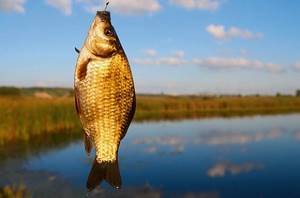
Fall fishing is especially affected by fluctuations in water temperature
At the beginning of autumn, it reacts to lower temperatures in a river or lake by beginning to intensively fatten up before winter. Therefore, the days after the first September or October frosts are perfect for fishing. As soon as the reservoir cools down to 11-12°C, the bite will noticeably decrease. At low water temperatures (about 8°C), crucian carp go to depths or bury themselves in silt, ceasing to bite on a wide variety of baits.
If the water becomes warmer, its oxygen regime changes significantly. The content of such an important substance is becoming less. Therefore, when going fishing from the end of May to August, pay attention to the temperature dynamics in a particular body of water.
Consider other points as well. Let’s say the weather is hot for several days and the water has become warmer by another 2-3°C, but the north wind is blowing. So one negative factor reduces the effect of another and it turns out that on such days the fish do not stop biting from morning until evening.
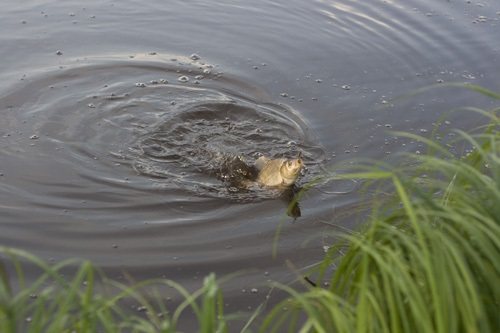
The start of the crucian bite in the spring depends on how quickly the water warms up
In spring, every increase in water and air temperatures has a beneficial effect on the bite. Different parts of the reservoir warm up, fish awaken after winter, the food supply increases due to the appearance of zooplankton, phytoplankton, algae, insect larvae, etc. In addition, the usual water level, which was exposed to the flood, is restored.
If there is a cold snap in the spring, especially a long one, then the fish begins to “get sick”. This manifests itself in inactivity and refusal of food. If spawning has already begun at that moment, then the crucian carp take a break from this important activity. The fish moves away from the shore and again hides in the holes where it spent the winter. This is why, due to a cold or late spring, spawning can begin even at the end of June.
